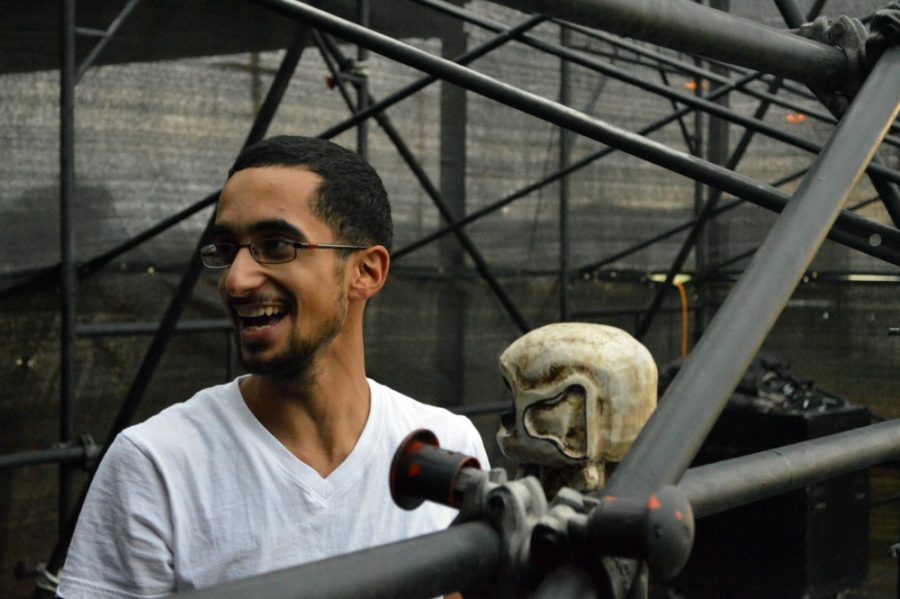As Johnny Ortiz looked out from the largest stage ever built in North America at Electric Daisy Carnival 2013 in Las Vegas, he saw 400,000 ecstatic, wide-eyed, dancing audience members. The engineering junior helped build the stage, as well as local projects at The SlaughterHouse and AVA Amphitheater, among others, and said the happiness from the fans is what drives his work.
“I’ve always loved concerts, and I’ve always wanted to be more involved with them,” Ortiz said. “As soon as your favorite artist comes out on the stage, the lights start going crazy, the music is as loud as it can be — you don’t really think about it. You just enjoy the magic.”
As part of the 400-person production crew, Ortiz helped make the magic happen. The 1.3 million-pound stage — rivaled in weight only by the 1984-86 reparation of the Statue of Liberty’s scaffolding — and the nearly half-a-million audience members gave the production crew a huge responsibility. Both the quality of the show and the crowd’s safety depended on the crew.
“You don’t want to have 400,000 people at a festival and have an 85-foot scaffolding structure fall on them,” Ortiz said. “That would be the last EDC.”
But the crew pulled it off in June, successfully building, rigging, maintaining and deconstructing the most notorious EDC yet. The lights, lasers, giant flower panels, towering mushrooms and colorful pyrotechnics all combined perfectly with the music to enthrall hundreds of thousands of festival-goers.
But EDC wasn’t Ortiz’s first time building a stage.
Ortiz got his start when he helped paint new scaffolding at The SlaughterHouse, where his brother, local rapper Mic Ortiz, had a gig.
“I got offered to go down there and help them paint some scaffolding that they were going to use to build the main stage,” Ortiz said. “I got there at 11 at night and stayed until three in the afternoon.”
After five months of volunteering at The SlaughterHouse and helping to build the main stage, officials gave him a spot on the payroll.
Since then, Ortiz has worked at other venues, setting up stages for acts such as Def Leppard and Cirque du Soleil, along with concerts at The SlaughterHouse.
Now, Ortiz is a mainstay at Digital Vibe Entertainment where he is among friends.
“He’s a cool guy,” DVE promoter Stephanie Medina said about Ortiz. “He’s pretty inspiring because he’s studying engineering, he has his stuff together, he has a job and he’s still able to do this on the side.”
Ortiz’s other work includes tutoring at Arizona College Prep Academy and working with James Thomas Productions, the company that ran EDC.
Cody Lisle, production manager for DVE and an audio engineer, helped Ortiz get the EDC job. Lisle said that he and CEO Brent Ahlstrom want Ortiz to become a partner with them at DVE, which runs productions for The SlaughterHouse and is pushing to better Tucson’s music and rave scenes.
“You don’t come across too many people willing to bust their ass for what little money we make right now,” Lisle said of Ortiz. “It’s more about the show than the cash. We love what we do.”
They aren’t exactly raking in $100 bills just yet. Lisle said most of their paychecks go to pay for lights and other stage elements.
The real money, according to Ortiz, is in stage design. He said he plans to continue building stages, but his dream is to design a robotic stage. Two stages he has in mind include an Iron Man stage, with mechanical arms and lasers coming out of the shoulders, and a spider stage. The spider’s body would tower above the crowd, but the DJ would perform inside the stomach.
He said he’s always wanted to build a robotic stage and that working with DVE could help him with that dream.
Until this semester, Ortiz said he hadn’t declared a focus for his engineering degree. Now, he’s focusing on mechanical engineering.
Building stages isn’t exactly mechanical engineering, he said, “but it’s physics and engineering all the way.”
Over the summer, Ortiz took a course in sound engineering that taught him about sound waves, which applies directly into creating a clean and balanced — and bearable — sound at shows.
“I’m using some of my civil engineering knowledge as well when it comes to structural integrity and how much weight we’re going to hang off of things and how secure something is,” he said.
For Ortiz, all of the hard work is worth it to “learn how the magic trick works” and to watch the crowd’s reaction. He recalled his favorite moment — when the fruit of his work became visible at Midway Music Festival.
“I was on top of the roof of SlaughterHouse, just soaking in everything,” he said. “It was during one of Krewella’s songs. When the drop came on, everyone in the crowd went bananas.”
Attendees at this year’s N9NE Fest on September 13 at The SlaughterHouse can see some of Ortiz’s labor in action.
— Follow Greg Gonzales on Twitter @Philoboarder43.









